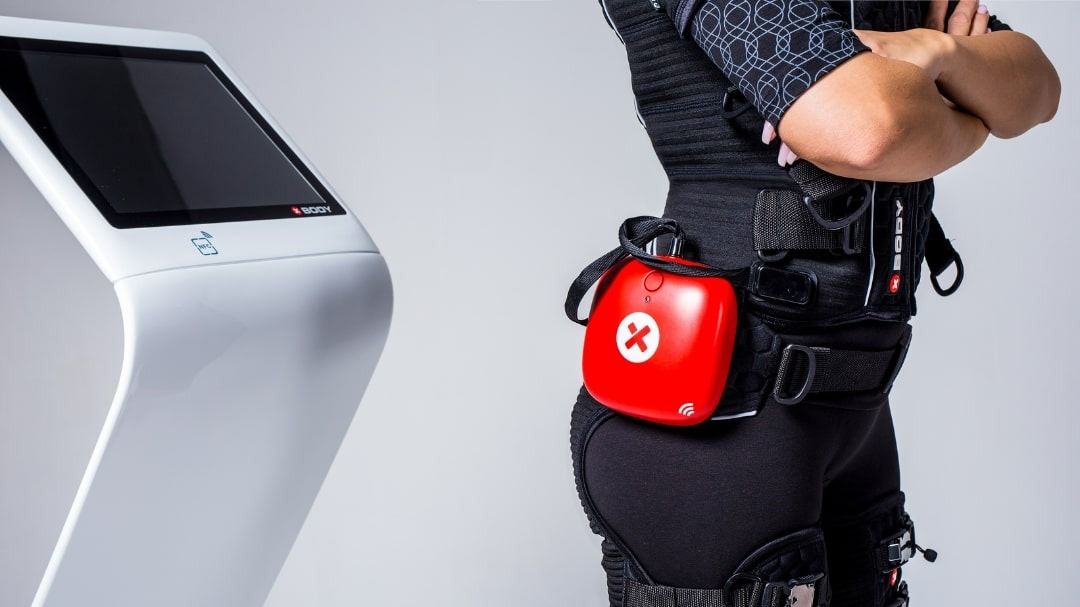EMS training explained: What is it and how does it work?
Curious about EMS training? Learn everything you need to know about this innovative workout method that utilises electrical muscle stimulation to activate your muscles and optimise your training results.
If you've been keeping a keen eye on the evolving world of fitness, you might have stumbled upon the term "EMS training" quite a few times, especially in the last year.
It seems like everyone, from top athletes to busy young adults, is giving this innovative training work a try as part of their new year resolutions or to jump-start their journey back to a vibrant young adult life.
But what exactly is this buzzword that's taking the fitness realm by storm? Well, you're about to find out!
EMS training, or Electrical Muscle Stimulation training, is not just a fleeting trend. It's a revolutionary approach that integrates cutting-edge EMS technology into the fitness sphere, promising body-toning results in less time compared to conventional training methods.
Imagine achieving the muscle strength and weight loss you've been dreaming of, but with a twist - a literal electric impulse twist, that is!
In this article, we're diving deep into the world of EMS training, unravelling the science behind it, and the potential benefits it can offer for improving muscle tone and strength.
Whether you're contemplating incorporating EMS into your regular workout or just curious about how electrical stimulation can play a role in muscle contraction and development, we've got you covered.
So, buckle up as we embark on this exciting journey, exploring everything from the tingling sensation you might feel during an EMS-training session to finding the best EMS machine for your needs.
Stay tuned, because by the end of this read, you'll be well-equipped with the knowledge to decide if EMS training is the electrifying boost your fitness routine has been waiting for!
.jpg)
Source: EMS Xperience
What is EMS training?
Now let's take a step back and venture into the fascinating origins and principles of EMS training. Trust us, understanding the nitty-gritty of this innovative approach will only heighten your appreciation for it!
Historical background
Before we venture into the modern wonders of EMS training, let's take a fascinating journey back in time to understand its deep-rooted history.
- 1761 - The inception of EMS can be traced back to this year when Italian physicist Luigi Galvani made the groundbreaking discovery that electric currents could indeed stimulate muscle movements, laying the foundation stone in the field of bioelectromagnetics.
- 1833 - The research baton was then passed to French neurologist Duchenne de Boulogne. He expanded upon Galvani's work, experimenting with 'electropuncture', a technique that used sharp electrodes under the skin to activate muscles, fostering a series of developments in electrical muscle stimulation therapies.
- 1960s - This decade saw the United States developing functional electrical stimulation (FES), primarily to aid stroke patients. The promising results, first published in the late 1970s, spurred numerous groups to explore the potential of FES treatments for individuals with spinal cord injuries.
- 1974 - A significant milestone was achieved by American neurosurgeon Clyde Norman Shealy, who introduced the TENS unit, a device designed to offer pain relief through electrical stimulation.
- 1976 - This year marked the Olympic debut of EMS training. Under the guidance of Dr. Yakov Kots from the USSR, Olympic athletes were the first to incorporate EMS into their training regimen, utilising a technique known as the Russian Stim or Kots Current, which employed a frequency of 2500 MHz to enhance athletic performance.
- 1990s - As we approached the end of the century, EMS training began making waves in gyms and physiotherapy centres. However, it was only in the mid-2000s that it blossomed into a renowned training method, thanks to advancements in technology and its adoption by professional athletes for sports training and recovery.
Modern EMS training
Now, let's talk about the present, where EMS training has become a buzzword in the fitness community, promising remarkable body-toning results in significantly less time. But how does it manage to do this?
At the core of EMS, or Electrical Muscle Stimulation, lies a powerful technology that utilises electronic impulses to activate major muscle groups in your body, a process that mimics the natural action of our central nervous system.
Imagine giving your muscle fibres a more direct, potent stimulation, encouraging growth and strength in a way that conventional training methods might take longer to achieve.
But it's not all about muscle fibre activation; it's about doing it smartly. Modern EMS systems are designed to target specific muscle groups selectively, allowing for a more focused and efficient workout.
Whether you're using a wearable device at a specialised studio or a home-use device under the guidance of a trained professional, EMS training work is all about optimising results while saving time.
Moreover, the EMS machine and other related equipment have evolved to become more user-friendly, offering customizable settings to suit individual needs and goals.
This means you can tailor your EMS workout to target specific areas, achieving the best results in a twenty-minute session, which might take hours with standard workout routines.
.jpeg)
Source: Body Street EMS
How does EMS training work?
Alright, now that we've taken a stroll down memory lane, let's delve into the heart of the matter: how does EMS training actually work? Strap in, because we're about to unravel the science behind this electrifying fitness revolution!
First things first, let's demystify the core principle behind EMS training: electrical muscle stimulation. In simple terms, this technology utilises electronic impulses to activate your muscle groups, a process that mirrors the natural actions of our central nervous system.
When you engage in a standard workout, your brain sends electrical impulses to stimulate certain muscle fibres. EMS technology takes this a notch higher, directly sending electrical impulses to your muscles and causing them to contract, thus potentially achieving more in a shorter time span.
The equipment
Now, onto the gear that makes it all possible. The market today is flooded with a range of EMS devices, from wearable devices that adhere to your body, to larger EMS machines found in specialised studios.
These gadgets are calibrated to ensure safety and efficacy, with settings that can be customised to suit individual fitness levels and goals.
It's essential to note that for the best results, one should always opt for equipment approved by trained professionals to avoid improper use of the equipment.
The process
So, what can you expect when you step into an EMS training session? Initially, you might experience a tingling sensation as the EMS device sends electric impulses to stimulate muscle contraction. But fear not, as this is a normal part of the process, and many find it quite exhilarating!
An EMS training work session typically lasts for about twenty minutes, a time frame that can potentially offer the same benefits as several hours of conventional exercise. This is because EMS technology allows for the simultaneous activation of various muscle groups, making your workout exceedingly efficient.
During the session, you'll be guided by an EMS operator or personal trainer who will help you navigate through different exercises, ensuring that you're getting the most out of your workout while maintaining a high metabolic state.
This guidance is crucial, as it helps in avoiding any potential pitfalls and ensuring that you're on the right track to achieving your fitness goals.
In recent years, studies have shown that individuals who incorporate EMS training into their routines have witnessed significant improvements in muscle strength and body composition.
For instance, a study published in the Frontiers in Public Health found that participants experienced a noticeable increase in muscle strength after just a few weeks of EMS training.
So, as you can see, EMS training is not just a buzzword; it's a scientifically backed method that promises to revolutionise the way we approach fitness, offering a potent blend of efficiency and effectiveness that is hard to beat.

Source: Pexels
Benefits of EMS training
EMS training comes with a plethora of benefits that can enhance your fitness journey. Here, we explore some of the notable advantages.
1. Muscle strength and tone
EMS training is like a magic wand for those seeking to enhance muscle strength. By targeting multiple muscle groups simultaneously, it ensures a comprehensive workout, helping you tone up and build muscle mass more efficiently.
For instance, Kots of the Central Institute of Physical Culture in the USSR claimed to see up to 30-40% strength gains in already-trained individuals using specific methods of EMS, making it a go-to choice for many fitness enthusiasts.
Read also: The top 5 most effective muscle-building supplements
2. Weight management and fat loss
If weight loss is your goal, EMS might be your new best friend.
By inducing a high metabolic state during workouts, it can potentially accelerate fat loss, helping you achieve your weight management goals in less time compared to conventional exercise methods.
3. Improved athletic performance and muscle recovery
But the benefits of EMS training aren't just confined to muscle building and weight loss.
Many top athletes have incorporated EMS into their training regimes to enhance performance and speed up muscle recovery.
The targeted electrical stimulation helps in efficiently working out specific muscle groups, aiding in quicker recovery and improved performance on the field.
4. Positive effects on metabolism and cardiovascular health
Beyond the muscles, EMS training can also have a positive impact on your metabolism and cardiovascular health.
By engaging in regular EMS workouts, you might notice an uptick in your metabolic rate, promoting better energy utilisation and potentially leading to improved heart health.

Source: Pexels
Potential risks and safety considerations
While we've been raving about the numerous benefits of EMS training, it's equally important to address the potential risks and safety considerations that come with it.
After all, being informed is the first step to a safe and successful fitness journey. Let's delve into the aspects you need to keep an eye on to make the most of your EMS training experience.
1. Proper use of EMS devices
First and foremost, the proper use of EMS devices cannot be stressed enough. These devices, though revolutionary, require a certain level of understanding and respect. It's crucial to follow the instructions meticulously to prevent any adverse effects.
Improper use of the equipment can potentially lead to muscle strains or even burns. Therefore, always ensure that you are using approved devices and following the guidelines set by trained professionals.
2. Seeking professional guidance
Embarking on your EMS training journey with the guidance of a professional is not just recommended but essential, and diversity hiring can be a thoughtful approach to finding the right trainer for your needs.
A trained professional or an EMS operator can help tailor the program to suit your individual needs, ensuring that the electrical impulses are administered at the right intensity and frequency. This personalised approach not only maximises the benefits but also significantly reduces the risk of injury.
3. Addressing potential side effects or discomfort
Like any other training regimen, EMS training comes with its own set of potential side effects or discomforts. Some individuals might experience a tingling sensation or muscle soreness, especially during the initial sessions.
It's essential to communicate any discomfort to your trainer promptly, allowing them to adjust the settings or the workout accordingly to ensure a comfortable and enjoyable experience.
Moreover, it's advisable to approach EMS training with a gradual mindset, allowing your body to adapt to the new form of stimulation without overwhelming it. Remember, the goal is to enhance your fitness journey, not to create a hurdle in it.
4. Recommendations for a successful EMS training experience
To reap the best results from your EMS training, here are a few golden rules:
- Consultation: Before you begin, consult with a healthcare provider, especially if you have pre-existing health conditions.
- Hydration: Stay well-hydrated before and after the sessions to support optimal muscle function.
- Balanced diet: Complement your training with a balanced diet to fuel your body adequately.
- Rest: Ensure sufficient rest between sessions to allow for proper muscle recovery.
By adhering to these guidelines and working closely with a trained professional, you can enjoy a safe and fruitful EMS training experience, paving the way for a healthier and fitter you.

Source: Pexels
Incorporating EMS training into your fitness routine
You might be wondering how to seamlessly weave this innovative method into your existing fitness routine. Well, you're in luck, because we're here to guide you on how to create a balanced, effective, and safe workout regimen with EMS. Let's get started!
1. Choosing the right EMS equipment or training studio
First things first, selecting the right EMS equipment or finding a reputable training studio is paramount. When it comes to home-use devices, ensure to opt for ones that are certified and have positive reviews from other users.
If you're leaning towards joining a studio, look for places that have experienced trainers and good testimonials. Remember, the quality of the equipment and the expertise of the trainer can significantly influence your overall experience and the results you achieve.
2. Creating a balanced workout routine
As you step into the world of EMS, it's vital to create a balanced workout routine that harmonises with your existing fitness regimen. EMS training is incredibly versatile, allowing you to focus on specific muscle groups or engage in full-body workouts.
Combining EMS training with conventional exercise can potentially enhance muscle mass and reduce body fat more effectively than traditional training alone.
3. Frequency and duration of EMS sessions
When it comes to the frequency and duration of EMS sessions, less is often more. A typical session lasts about twenty minutes, providing an intensive workout that can equate to hours of conventional training.
It's recommended to start with one to two sessions per week, allowing adequate time for muscle recovery between sessions. As you progress, you can adjust the frequency based on your comfort level and goals.
4. Combining EMS training with other workout modalities
To reap the maximum benefits, consider combining EMS training with other workout modalities.
For instance, you might alternate between EMS sessions and cardio workouts to create a well-rounded fitness routine.
This approach not only prevents workout monotony but also ensures that you are working on different aspects of fitness, from muscle strength to cardiovascular health.
5. Tips for a successful EMS training experience
To ensure a successful EMS training experience, here are a few tips to keep in mind:
- Personalised approach: Work closely with your trainer to develop a personalised plan that aligns with your fitness goals.
- Progressive overload: Gradually increase the intensity of your sessions to challenge your muscles and achieve continuous improvement.
- Nutrition: Don't forget the role of nutrition in achieving your fitness goals. A balanced diet can significantly complement your EMS training efforts.
Conclusion
Well, we've embarked on quite a journey today, haven't we? From the historical roots of electrical muscle stimulation to the buzzing world of modern EMS training, we've covered a lot of ground together.
As we stand at this juncture, ready to embrace the electrifying potential of EMS training, it's essential to take a moment to reflect on what we've learned.
EMS training, as we've seen, is more than just a fleeting trend. It's a scientifically-backed approach that promises not only to revolutionise our fitness routines but also to potentially usher in a new era of health and well-being.
Whether you're a fitness newbie looking to jump-start your journey or a seasoned athlete aiming to enhance your performance, EMS training offers a versatile and efficient solution.
But remember, like with any fitness regimen, the key to success lies in a balanced approach. It's about integrating EMS training into your routine in a way that complements your existing workouts, not replaces them.
And let's not forget the importance of working with trained professionals who can guide you safely and effectively towards your goals.
As we wrap up, we encourage you to approach EMS training with an open mind and a readiness to explore. Who knows, it might just be the missing piece in your fitness puzzle, offering a fresh and exciting way to achieve your health goals.
So why not give it a try? After all, in the dynamic world of fitness, it's always a great time to embrace new beginnings and opportunities.
Friska 🐨
Read next: What is Bungee Fitness and where to try it in Singapore?
FAQs (Frequently Asked Questions)
1. Is EMS training safe?
Yes, when conducted under the guidance of a certified trainer and with proper equipment, EMS training is generally considered safe. However, it's essential to communicate any discomfort or concerns with your trainer to avoid potential side effects.
2. Can anyone do EMS training, or are there specific restrictions?
While most people can benefit from EMS training, certain groups, including pregnant women and individuals with specific medical conditions, should avoid it. Always consult with a healthcare provider before starting a new fitness regimen.
3. How often should I do EMS training to see results?
The frequency of EMS training sessions can vary based on individual goals and fitness levels. Generally, it is recommended to start with one to two sessions per week, with each session lasting about 20 to 30 minutes.
4. Will EMS training replace my regular workouts, or should it be incorporated alongside other exercises?
EMS training can be a standalone workout regimen or incorporated alongside other exercises. Combining EMS training with conventional workouts can offer a well-rounded approach to fitness, targeting different muscle groups and enhancing overall results.
Source
- Frontiers | Effects of whole-body electromyostimulation training on upper limb muscles strength and body composition in moderately trained males: A randomized controlled study (frontiersin.org)
- Electric Muscle Stimulation - An Athletic Advantage? | BMEG442: Engineering Exercise and Sports (udel.edu)
- Effects of whole-body ELECTROMYOSTIMULATION on health and performance: a systematic review | BMC Complementary Medicine and Therapies | Full Text (biomedcentral.com)
- How to Get Fit Using Electrical Muscle Stimulation (EMS) - Scientific American
- Electrical Muscle Stimulation: What You Need to Know (menshealth.com)

